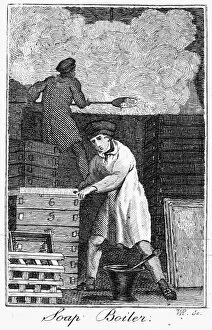Soap Maker Collection
The art of soap making has a rich history, spanning across different countries and centuries
All Professionally Made to Order for Quick Shipping
The art of soap making has a rich history, spanning across different countries and centuries. From the Sunlight Soap advertisement in The Illustrated London News Diamond Jubilee Number to the bustling soap factories in 18th-century France, the process of creating this essential household item has evolved over time. In c1870 Paris, we catch a glimpse into an animal-fat soap factory's boiling room. Wood engravings depict workers diligently tending to large cauldrons filled with bubbling mixtures. Meanwhile, in another French factory specializing in olive oil-soap production, hardened cakes are skillfully cut using draw-knives and iron wires. Traveling back further to colonial America during the late 18th century, we witness a colonial soapmaker being assisted by an indentured servant. This line engraving showcases the collaborative effort required for successful soap production during that era. As we delve deeper into history, mid-18th century France reveals its secrets of enriching olive oil-lye mixtures with additional oils as saponification progresses. Lye is carefully added slowly to olive oil within large boilers while tanks of lye in varying strengths line the side walls of these bustling factories. Slicing hardened cakes vertically or horizontally was also part of the intricate process involved in producing high-quality soaps during this period. Cleavers and iron wires were employed for precision cutting purposes. Cross-sections provide us with insights into steam-heated soap boilers used extensively within French factories around c1870. These innovative advancements allowed for more efficient and controlled heating processes. Finally, our journey takes us to Marseilles where a picturesque scene unfolds – a French olive oil-soap factory's boiling room captured through wood engravings from c1870. Workers can be seen meticulously attending to their tasks amidst rows of cauldrons filled with steaming mixtures. These captivating images offer glimpses into various aspects of soap manufacture throughout history – from the ingredients used to the techniques employed.















